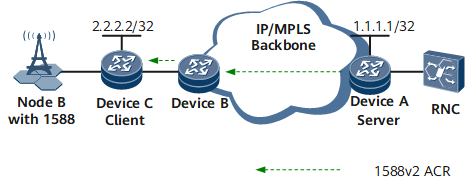Example for Configuring 1588 ACR Clock Synchronization in a Single-Server Scenario
This section describes how to configure 1588 ACR on the router functioning as a client and the router functioning as a server to restore clock information in a single-server scenario by using an example.
Networking Requirements
On the IP RAN shown in Figure 1, DeviceA functions as a clock server. DeviceC functions as a client, and sends a 1588 ACR Layer 3 unicast negotiation request to the server to achieve clock synchronization.
Configuration Roadmap
The configuration roadmap is as follows:
Configure DeviceA as a server.
Configure DeviceC as a client.
Adjust Layer 3 unicast negotiation parameters on the server and the client.
Configure unicast negotiation on the server and client.
On the client, configure a PTP clock reference source.
Data Preparation
To complete the configuration, you need the following data:
IP address of the server and the IP address of the client
Interval for sending Sync, Delay_Resp and Announce packets on the server
Procedure
- Configure DeviceA as a server.
<DeviceA> system-view [~DeviceA] interface loopback 0 [*DeviceA-Loopback0] ip address 1.1.1.1 32 [*DeviceC-Loopback0] commit [~DeviceA-Loopback0] quit [*DeviceA] ptp-adaptive enable [*DeviceA] ptp-adaptive device-type server [*DeviceA] ptp-adaptive local-ip 1.1.1.1 [~DeviceA] commit
- Configure Device C as a client.
<DeviceC> system-view [~DeviceC] interface loopback 0 [*DeviceC-Loopback0] ip address 2.2.2.2 32 [*DeviceC-Loopback0] commit [~DeviceC-Loopback0] quit [*DeviceC] ptp-adaptive enable [*DeviceC] ptp-adaptive device-type client [*DeviceC] ptp-adaptive local-ip 2.2.2.2 [*DeviceC] ptp-adaptive remote-server1-ip 1.1.1.1 [~DeviceC] commit
- Adjust Layer 3 unicast negotiation parameters on the client and the server.
# Configure the client.
[*DeviceC] ptp-adaptive request sync-interval 4 [*DeviceC] ptp-adaptive request announce-interval 12 [*DeviceC] ptp-adaptive request delay-resp-interval 6 [*DeviceC] commit
- Configure unicast negotiation on the server and client.
# Configure the server.
[*DeviceA] ptp-adaptive acr unicast-negotiate enable [*DeviceA] commit
# Configure the client.
[*DeviceC] ptp-adaptive acr unicast-negotiate enable [*DeviceC] commit
- On the client, configure a PTP clock reference source.
[*DeviceC] clock source ptp synchronization enable [*DeviceC] clock source ptp priority 1 [*DeviceC] clock source ptp ssm prc [*DeviceC] commit
- Verify the configuration.
# Check the 1588 ACR configuration on DeviceC.
<DeviceC> display ptp-adaptive all Device config info --------------------------------------------------------------------------- Ptp adaptive state :enable Device type :client Sync mode :frequency Current state :slave Packet dscp :56 Domain value :0 Announce interval :12 Announce duration :300s Sync interval :4 Sync duration :300s Delay_resp interval :6 Delay_resp duration:300s Announce receipt timeout:3 Acr mode :one-way Local ip :2.2.2.2 Client board :3 Frequency profile :no VPN :none BMCA run info --------------------------------------------------------------------------- Current trace source :server1 Frequency lock success :yes Time performance statistics(ns): ------------------------------------------------------------------------ Realtime(T2-T1) :987740873 Max(T2-T1) :987742555 Min(T2-T1) :987423502 Remote server info --------------------------------------------------------------------------- Ip address Negotiate state Pri1 Class Accuracy Pri2 Server1: 1.1.1.1 Nego success 128 6 0x34 128 Server2:
# Check the 1588 ACR configuration on DeviceA.
<DeviceA> display ptp-adaptive all Device config info --------------------------------------------------------------------------- Ptp adaptive state :enable Device type :server Sync mode :frequency Current state :master Packet dscp :56 Domain value :0 Local ip :1.1.1.1 Server board :3 Frequency profile :no VPN :none Client info ID Ip Address Clock ID Mode Announce Sync Delay_resp --------------------------------------------------------------------------- 1 0 2.2.2.2 001882fffed48301 one-way 2 -6 none
Configuration Files
Configuration file of DeviceA
# sysname DeviceA # ptp-adaptive enable ptp-adaptive device-type server ptp-adaptive local-ip 1.1.1.1 ptp-adaptive acr unicast-negotiate enable # interface Loopback0 ip address 1.1.1.1 255.255.255.255 # returnConfiguration file of DeviceC
# sysname DeviceC # ptp-adaptive enable ptp-adaptive device-type client ptp-adaptive local-ip 2.2.2.2 ptp-adaptive remote-server1-ip 1.1.1.1 ptp-adaptive request sync-interval 4 ptp-adaptive request announce-interval 12 ptp-adaptive request delay-resp-interval 6 ptp-adaptive acr unicast-negotiate enable clock source ptp synchronization enable clock source ptp priority 1 clock source ptp ssm prc # interface Loopback0 ip address 2.2.2.2 255.255.255.255 # return
